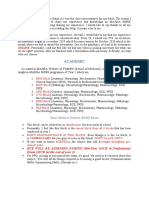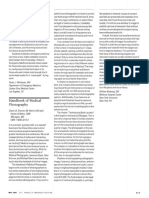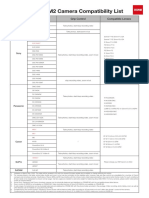Pediatric Emergency Medicine Secrets Ymem
Pediatric Emergency Medicine Secrets Ymem
Uploaded by
AGGREY DUDUCopyright:
Available Formats
Pediatric Emergency Medicine Secrets Ymem
Pediatric Emergency Medicine Secrets Ymem
Uploaded by
AGGREY DUDUCopyright
Available Formats
Share this document
Did you find this document useful?
Is this content inappropriate?
Copyright:
Available Formats
Pediatric Emergency Medicine Secrets Ymem
Pediatric Emergency Medicine Secrets Ymem
Uploaded by
AGGREY DUDUCopyright:
Available Formats
Book Reviews
Pediatric Emergency Medicine Secrets Pediatric Emergency long, allowing the physician to quickly scan
Review by Paula y. Whiteman, MD for pertinent information when a "refresher"
Medicine Secrets about the differential diagnosis of a particu-
Handbook of Medical Photography lar patient is needed.
Selbst SM, CronanK (eds)
Review by William Birdsong, MD However, a number of the chapters are
Hanley & Belfus, 2001
much longer, providing extensive overviews of
Copyright © 2001 by the College of Emergency 425 pages, $39
Physicians.
their subjects with tables and treatment alter-
ISBN 1-56053-411-7
natives. The chapter on infectious diseases,
0196-0644/2001/$35.00 + 0
This book is another fine addition to the for example, discusses the all-important
47181114534
doi: l O.l O671mem.2001.114534 Secrets Series. The emphasis of this manual issue of age range when approaching the
is on the need-to-know pearls of pediatric very common complaint of fever and also dis-
emergency medicine. The editors have done cusses organ systems with multiple tables to
a superb job of pulling together 68 chapters help guide treatment decisions. Similarly, the
written by an equal number of experts in their chapter on poisoning covers this complex
fields to create a volume from which pediatri- topic in a detailed and concise fashion. It
cians and emergency physicians will both highlights the concept of "deadly in a dose"
benefit. as it applies to the toddler.
The chapters are logically arranged with Each chapter is arranged in a highly read-
the most critical, those dealing with ad- able question-and-answer format, and many
vanced life support, presented in the first of the chapters are interspersed with cases
section. These are followed by 25 chapters, to emphasize key points. For example, chap-
each dealing with the primary pediatric com- ter 19, which addresses "limp" as a symptom,
plaints that are most likelyto be encountered both uses the question-and-answer format to
in an emergency department, such as ear highl ight the important approach to a patient
pain, fever, or foreign bodies. These chapters with this problem and uses multiple-choice
are followed by sections on medical emer- questions and several pertinent cases to
gencies, surgical emergencies, and trauma. focus the reader on the most important causes
Environmental emergencies and special top- to consider in the differential. Dr. Shaw's
ics conclude the book. The ease with which chapter on fluids and electrolytes provides
one can find the information should make this the necessary formulas to approach the fre-
book an invaluable quick reference for medi- quent problem of dehydration and gives case
cal students and residents rotating through examples to illustrate howto workthrough
the emergency department. Indeed, I wish the calculations for dispensing the appropri-
the book had been around when I was a pedi- ate fluids.
atric emergency fel low itwould have made a Pediatric EmergencyMedicine Secretsis
welcome addition to my reading as I reviewed similar in layout to Synopsisof Pediatric
for my board examinations. EmergencyMedicineby Gary R. Fleisher and
This book is compact enough to be kept Stephen Ludwig, which is considerably longer
handy when working a clinical shift. Most of and more of an abbreviated reference book.
the chapters are no more than 5 or 6 pages Pediatric EmergencyMedicineSecretsalso
5 5 4 A N N A L S OF EMERGENCY MEDICINE 375 MAY 2001
BOOK REVIEWS
contains illustrative radiographs, which are publish your photographs in a book or journal, the weakest in the book. Issues of consent
not generally a part ofthe Secrets Series. use them as part of the medical record, show and libel are presented with examples from
The McGraw-Hill PediatricEmergency them at a major conference, or submit them case law, but I found the prose to be a bit
Medicine: A ComprehensiveStudyGuideis as legal or forensic evidence, it probably muddy. I'm still not sure whether it is legal to
slightly longer but is not as handy for quick won't be adequate to whip out your pocket publish a picture of someone's foot without
reference. Its chapters are in text format and digital or 35-mm camera. We are talking written consent despite this subject having
provide a more thorough overview. about a small closet full of equipment at a been addressed explicitly.
Lastly, Crain's ClinicalManual of Emer- substantial investment of money and time if Overall, this book is an excellent technical
gency Pediatrics is also a close competitor. you want to do it right. manual for those seeking to produce the high-
This book is also concise with an emphasis on If you already know the basic principles of est quality medical images for publication.
management and disposition advice for spe- photography, you may enjoy reviewing them Those of us with less stringent requirements
cific illnesses, but the writing style and sec- in the context of medical practice. F-stops, probably won't benefit from the largest sec-
tion layout are quite different. shutter speeds, lighting, and film selection tion on regional anatomy. This and the fact
Students of pediatric emergency medicine all are important and depend on the clinical that many of the remaining chapters are
now have a new, highly readable volume to context. Did you know that there is a special redundant make me wonder whether most of
help sharpen their knowledge. Pediatric kind of film that is specially made for shoot- the useful information could have been pre-
EmergencyMedicine Secretsis best suited ing pictures of x-rays or that different rashes sented in a much smaller, less expensive for-
for those who enjoy memory tools, mnemon- require different kinds of lighting? The chap- mat, perhaps even in a short series of journal
ics, and quizzes to help them learn or for ter on technique is excellent and demon- articles. It is obvious that the book's editors
those who want a book small enough that it strates through specific examples and some share a common passion for medical photog-
can be kept nearby for a "sneak peak" during well-chosen figures exactly why some pho- raphy and that they hope to bring the rest of
work. tographs are much better than others. us up to their level, i'm just not sure that you
Paula J. Whiteman, MD A chapter on equipment is a bit redun- need this book if all you want to do is make it
Department of EmergencyMedicine dant, but it clearly demonstrates how know- abundantly clear that the crater on the screen
Cedars-SinaiMedical Center ing what all those little buttons on the back of is on the penis and not on Venus.
Los Angeles, CA your high-end 35-mm SLR camera do can William Birdsong, MD
really expand your repertoire of photographic Bellevue Hospital Center
options. Additionally, ifyou have ever at- New YorkUniversity
Handbook of Medical tempted and failed (as I have)to capture a New York,NY
lengthy surgical procedure on film, you will
Photography appreciate the section on photography in the
operating room.
Stack LB, StorrowAB, Morris/VIA (eds)
The chapter "Technique by Body Location"
Hanley & Belfus, 2000
is the largest in the book at 330 pages. This is
469 pages, $55
basically a regional atlas of surface anatomy
ISBN 1-5605-3213-0
that explains how to shoot pictures of every
Is it an armpit, a gluteal cleft, or a swamp? part ofthe human bodyto achieve textbook-
Questions like these often come to mind quality images. The photographs in this sec-
when someone projects medical photo- tion are beautiful and are arranged at the top
graphic handiwork at a conference. We've all ofthe left-hand page with a textual outline of
snapped photos of rashes and interesting the technique below. On the facing page a
lesions, but how many of us really know what line drawing illustrates the setup and the
we're doing? Medical images can be more manner in which each photograph was taken.
descriptive than the most eloquent prose, or This chapter is invaluable for those who seek
they can be downright confusing. With the to attain the highest quality images, but most
recent publication of the Handbookof of the setups are too elaborate for most prac-
Medical Photography, Lawrence Stack, Alan tical, day-to-day applications.
Storrow, and Michael Morris are clearly hop- Chapters on photographing radiographic
ing to raise the standards of clinical images. images, forensics, photojournalism, and stor-
The Handbookof Medical Photography age all are clearly written and useful, and an
begins with a review of what equipment to essay on digital photography makes it clear
buy and an explanation of why digital photog- that it is virtually impossible to take excellent
raphy is not yet adequate. It quickly becomes digital photographs without a camera that
apparent that this book is intended for the costs $16,000. The final chapter on the legal
serious medical photographer. If you want to aspects of medical photography is, perhaps,
MAY 2001 375 ANNALS OF EMERGENCY M E D r c I N E 5 55
You might also like
- On Call Surgery 4th EditionDocument643 pagesOn Call Surgery 4th Editiongrandstevejones JonesNo ratings yet
- MBBS Resources For Medical Students of BangladeshDocument31 pagesMBBS Resources For Medical Students of BangladeshBroglieNo ratings yet
- Full Chapter Volpe S Neurology of The Newborn 7Th Edition Joseph J Volpe PDFDocument53 pagesFull Chapter Volpe S Neurology of The Newborn 7Th Edition Joseph J Volpe PDFdennis.davis980No ratings yet
- MRCPCH MasterCourse 2 Volume Set 1st EditionDocument860 pagesMRCPCH MasterCourse 2 Volume Set 1st EditionJean Libay PekasNo ratings yet
- GI Visuals From Emergency Medicine Board Review For Visual LearnersDocument40 pagesGI Visuals From Emergency Medicine Board Review For Visual LearnersIanNo ratings yet
- Netter's Illustrated Human Pathology: Medical SciencesDocument1 pageNetter's Illustrated Human Pathology: Medical SciencesBrittanyNo ratings yet
- Mrs BridgeDocument2 pagesMrs BridgeJorge MonteroNo ratings yet
- Application Form Residency & PostRes 2022Document2 pagesApplication Form Residency & PostRes 2022Franz Libre100% (1)
- Netter S Illustrated Pharmacology, 2004-4Document7 pagesNetter S Illustrated Pharmacology, 2004-4ALNAKINo ratings yet
- Kaplan Classroom Anywhere Usmle Step 1 Lecture VideosDocument1 pageKaplan Classroom Anywhere Usmle Step 1 Lecture Videosabdul moeez cheema0% (3)
- Primary Care of Musculoskeletal Problems in The Outpatient SDocument350 pagesPrimary Care of Musculoskeletal Problems in The Outpatient SIqbal HabibieNo ratings yet
- Ophthalmology For The Primary Care PhysicianDocument393 pagesOphthalmology For The Primary Care PhysicianCatana TudorNo ratings yet
- Tutorials in Paediatric Differential Diagnosis 2ndDocument2 pagesTutorials in Paediatric Differential Diagnosis 2ndYouzuf Iqbal100% (1)
- Appendix 4M - Paediatric Emergency MedicineDocument21 pagesAppendix 4M - Paediatric Emergency MedicineEssam HassanNo ratings yet
- DNB Radio Diagnosis Paper4Document4 pagesDNB Radio Diagnosis Paper4Taha IsmailNo ratings yet
- Dokumen - Pub - Clinical Neurology Made Easy 1nbsped 9789390020409 9789352702510Document217 pagesDokumen - Pub - Clinical Neurology Made Easy 1nbsped 9789390020409 9789352702510Prajwal Bikram shahiNo ratings yet
- DNB Respiratory Medicine Paper4Document4 pagesDNB Respiratory Medicine Paper4aparnapingali00% (1)
- Kalaazar MX Guideline 22.06.2015Document100 pagesKalaazar MX Guideline 22.06.2015Child HealersNo ratings yet
- PG Guide BooksDocument4 pagesPG Guide BooksKingKamalNo ratings yet
- A KhamDocument324 pagesA KhamQuang NhânNo ratings yet
- MRCPI Combined General Medicine Regulations 2018Document32 pagesMRCPI Combined General Medicine Regulations 2018Shoukat MirzaNo ratings yet
- DNB General Surgery Paper3Document4 pagesDNB General Surgery Paper3Malavika RaoNo ratings yet
- Emergency MedicineDocument6 pagesEmergency MedicineAnnisa Agna PuspatamiNo ratings yet
- CPR, AED and First Aid Certification Course - UdemyDocument8 pagesCPR, AED and First Aid Certification Course - UdemyAmirul AsyrafNo ratings yet
- For PublicDocument6 pagesFor PublicMOHAMAD ZAHIN HAFIZ BIN ZULKIPLENo ratings yet
- Anatomy Shelf NotesDocument200 pagesAnatomy Shelf NotesJad MitriNo ratings yet
- Peripheral Arterial Disease, Peripheral Vascular DiseaseDocument31 pagesPeripheral Arterial Disease, Peripheral Vascular Diseasecpradheep100% (2)
- DNB Emergency Medicine Paper4Document5 pagesDNB Emergency Medicine Paper4Vaishnavi Agrawal100% (1)
- 2nd Yr Surgery - by S. Das - Sixth Edition (1) - 1-195Document195 pages2nd Yr Surgery - by S. Das - Sixth Edition (1) - 1-195Yogesh KharcheNo ratings yet
- Book Entitled Pediatric Clinical Methods MeharbanDocument2 pagesBook Entitled Pediatric Clinical Methods MeharbanJyoti KumariNo ratings yet
- International Residency Training Brochure 2023Document22 pagesInternational Residency Training Brochure 2023Kushal BhatiaNo ratings yet
- Residency Prospectus 2021-2022Document84 pagesResidency Prospectus 2021-2022Deepak NathiyaNo ratings yet
- Road Map - MedicineDocument1 pageRoad Map - MedicineEnjie IbrahimNo ratings yet
- Medical Books of MbbsDocument9 pagesMedical Books of MbbsFarrukh ZamanNo ratings yet
- ASBP Obesity Algorithm PDFDocument85 pagesASBP Obesity Algorithm PDFAna-Maria CroitoruNo ratings yet
- Vishram Singh - Selective Anatomy - Prep Manual For Undergraduates (Vol - 2) - 2E. 2-Elsevier (INR) (2020)Document468 pagesVishram Singh - Selective Anatomy - Prep Manual For Undergraduates (Vol - 2) - 2E. 2-Elsevier (INR) (2020)Pappu Kumar100% (1)
- Case PresentationDocument15 pagesCase PresentationmaymymayNo ratings yet
- GraphPad Ebook - Essential Dos Don'TsDocument10 pagesGraphPad Ebook - Essential Dos Don'TsNikunj MittalNo ratings yet
- Guidelines For Evaluation and Management of LBPDocument482 pagesGuidelines For Evaluation and Management of LBPShashi JainNo ratings yet
- 52 Q. Medicine 2nd Half PDFDocument15 pages52 Q. Medicine 2nd Half PDFFahad2036No ratings yet
- 12-Endocrinology & DiabetesDocument2 pages12-Endocrinology & DiabetesIbrahimFikryNo ratings yet
- A Short Textbook of Chemical Pathology - CompressDocument2 pagesA Short Textbook of Chemical Pathology - CompressGul e rana100% (1)
- Details of Students Admitted Through NEET SS 2022 23Document183 pagesDetails of Students Admitted Through NEET SS 2022 23belagupta13No ratings yet
- Pediatrics Logbook For UG Pediatrics 2021Document80 pagesPediatrics Logbook For UG Pediatrics 2021Ram KumarNo ratings yet
- Ophthalmology: Clinical Methods inDocument20 pagesOphthalmology: Clinical Methods inwarkhungam khumloNo ratings yet
- Graber and Wilburs Family Medicine Exami PDFDocument8 pagesGraber and Wilburs Family Medicine Exami PDFDiorella Marie López GonzálezNo ratings yet
- 2414 5 MediaDocument39 pages2414 5 MediarockNo ratings yet
- UntitledDocument340 pagesUntitledAlistair KohNo ratings yet
- 20 BR API Textbook of MedicineDocument1 page20 BR API Textbook of MedicinePrachi GuptaNo ratings yet
- Abg CasesDocument22 pagesAbg CasesNehal ElsaidNo ratings yet
- DNB Emergency Medicine Paper3Document5 pagesDNB Emergency Medicine Paper3Vaishnavi Agrawal100% (1)
- B D Chourasiya General Anatomy PDF by DR OMDocument276 pagesB D Chourasiya General Anatomy PDF by DR OMHamza bajwaNo ratings yet
- DNB Emergency Medicine Paper2Document5 pagesDNB Emergency Medicine Paper2Vaishnavi Agrawal100% (1)
- PDFDocument342 pagesPDFZae M HakimNo ratings yet
- SOAP Note Directions & AbbreviationsDocument4 pagesSOAP Note Directions & AbbreviationsTyler KingNo ratings yet
- Full Download Goldman-Cecil Medicine 26th Edition Lee Goldman PDFDocument64 pagesFull Download Goldman-Cecil Medicine 26th Edition Lee Goldman PDFthuiassano100% (3)
- Final ScribdDocument23 pagesFinal Scribdsellewolfecg664No ratings yet
- (A Case-Based Approach) Yang Tang, Sugoto Mukherjee, Max Wintermark - Emergency Neuroradiology - A Case-Based Approach-Cambridge University Press (2015)Document418 pages(A Case-Based Approach) Yang Tang, Sugoto Mukherjee, Max Wintermark - Emergency Neuroradiology - A Case-Based Approach-Cambridge University Press (2015)Thanh HằngNo ratings yet
- (Essentials Series) Ramesh Iyer, Teresa Chapman - Pediatric Imaging - The Essentials-LWW (2015)Document1,654 pages(Essentials Series) Ramesh Iyer, Teresa Chapman - Pediatric Imaging - The Essentials-LWW (2015)Milton David Daza ArevaloNo ratings yet
- Last Minute First Aid Notes by DR Noor Ul BasarDocument114 pagesLast Minute First Aid Notes by DR Noor Ul BasarMudassar Sattar100% (1)
- Pediatric EmergencyDocument1 pagePediatric EmergencycilengsaiNo ratings yet
- Pulmonary Embolism Making Sense of The DiagnosticDocument11 pagesPulmonary Embolism Making Sense of The DiagnosticAGGREY DUDUNo ratings yet
- Accuracy of Imaging Technologies in The DiagnosisDocument7 pagesAccuracy of Imaging Technologies in The DiagnosisAGGREY DUDUNo ratings yet
- A Room With A View On Call Specialist Panels andDocument4 pagesA Room With A View On Call Specialist Panels andAGGREY DUDUNo ratings yet
- Accuracy and Clinical Effect of Out of Hospital ElDocument10 pagesAccuracy and Clinical Effect of Out of Hospital ElAGGREY DUDUNo ratings yet
- Sensitivity of The SimpliRED Span Class Small DDocument2 pagesSensitivity of The SimpliRED Span Class Small DAGGREY DUDUNo ratings yet
- Recognizing Major Donors YmemDocument1 pageRecognizing Major Donors YmemAGGREY DUDUNo ratings yet
- How To Boot From A Usb Device 6609 LzhawgDocument11 pagesHow To Boot From A Usb Device 6609 LzhawgAGGREY DUDUNo ratings yet
- Handbook of Medical Photography YmemDocument1 pageHandbook of Medical Photography YmemAGGREY DUDUNo ratings yet
- Get Off Balance Painted Bay 1 1st Edition Jay Hogan Hogan Jay PDF Full ChapterDocument24 pagesGet Off Balance Painted Bay 1 1st Edition Jay Hogan Hogan Jay PDF Full Chapterluuciibessai100% (6)
- Our Obsession With Taking Photos These Days Cannot Be DeniedDocument2 pagesOur Obsession With Taking Photos These Days Cannot Be DeniedAn Khang100% (1)
- MR Spencer.251 523Document273 pagesMR Spencer.251 523Teo Adamescu100% (1)
- Gem NotesDocument97 pagesGem NotesArmando Michel Gabriel Cury FilhoNo ratings yet
- Price List PhotographyDocument6 pagesPrice List PhotographyfauzanneoimageNo ratings yet
- CRANE-M2 Camera Compatibility List En)Document1 pageCRANE-M2 Camera Compatibility List En)Agus SupriadiNo ratings yet
- ISE II Sample Paper 7 (With Answers) - 3Document1 pageISE II Sample Paper 7 (With Answers) - 3Nguyễn TườngNo ratings yet
- Village Roadshow Theme ParksDocument2 pagesVillage Roadshow Theme ParksSajith Ranjeewa SenevirathneNo ratings yet
- Pinhole Cameras and EyesDocument5 pagesPinhole Cameras and Eyesapi-251258441No ratings yet
- Video Camera EquipmentsDocument12 pagesVideo Camera EquipmentsKhushi JaiswalNo ratings yet
- Forensic PhotographyDocument38 pagesForensic PhotographyLeslie BanaagNo ratings yet
- Vision 3 ProDocument80 pagesVision 3 ProJesús SantiagoNo ratings yet
- Camera LensDocument11 pagesCamera LensRichelle CastilloNo ratings yet
- Over The Hump: A Great Northern Railway FolioDocument26 pagesOver The Hump: A Great Northern Railway FolioGordon Clark100% (1)
- Strand Century Lighting 2333-2334 6x16-Inch Lekolite Ellipsoidal Spotlight Spec Sheet 6-77Document2 pagesStrand Century Lighting 2333-2334 6x16-Inch Lekolite Ellipsoidal Spotlight Spec Sheet 6-77Alan MastersNo ratings yet
- First Pictures, Early Concepts - Early Concept BooksDocument25 pagesFirst Pictures, Early Concepts - Early Concept Booksdoraszujo1994No ratings yet
- StudioDocument4 pagesStudioarianne.s.amoresNo ratings yet
- BennyDocument3 pagesBennyDee Fue deeNo ratings yet
- Test Paper 1 - tcm143-592681Document11 pagesTest Paper 1 - tcm143-592681Inna GlushkovaNo ratings yet
- Mexican Contemporary Photography: Staging Ethnicity and CitizenshipDocument30 pagesMexican Contemporary Photography: Staging Ethnicity and CitizenshipjapaNo ratings yet
- Minolta Macro Rokkor Len ManualDocument12 pagesMinolta Macro Rokkor Len ManualazamamaNo ratings yet
- Film Language: Film Form and Meaning: (Notes On How To Analyse A Film by Geetha Bakilapadavu)Document21 pagesFilm Language: Film Form and Meaning: (Notes On How To Analyse A Film by Geetha Bakilapadavu)VikramNo ratings yet
- Etech Q3 M2Document4 pagesEtech Q3 M2Mariam GamosNo ratings yet
- Underwater Optics As Symbolic FormDocument23 pagesUnderwater Optics As Symbolic Formagathebtz64No ratings yet
- A Practical Approach To Clinical Photography (III)Document6 pagesA Practical Approach To Clinical Photography (III)Stefani TCNo ratings yet
- The Sample of The Test: General EnglishDocument17 pagesThe Sample of The Test: General EnglishcinnamoshkaNo ratings yet
- 8mm Film Tips and TechniquesDocument8 pages8mm Film Tips and Techniquesapi-3759623No ratings yet
- HWT D320 VFDocument3 pagesHWT D320 VFjolivenzaseguriNo ratings yet
- EF3e_intplus_filetest_3a-CHECKEDDocument5 pagesEF3e_intplus_filetest_3a-CHECKEDminamkoNo ratings yet

































































































